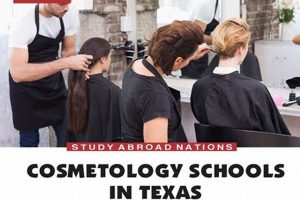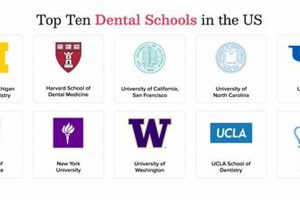Top-tier veterinary programs within the United States offer rigorous training in animal medicine, surgery, and research. These institutions often feature state-of-the-art facilities, renowned faculty, and diverse clinical experiences. For instance, students may gain hands-on experience with a wide range of species, from companion animals to livestock and exotics, preparing them for varied career paths.
Access to high-quality veterinary education is crucial for advancing animal health and welfare. Graduates of leading programs are equipped to address complex medical challenges, contribute to scientific discovery, and promote public health initiatives related to animal-borne diseases. Historically, the development of prestigious veterinary schools in the US has mirrored advancements in medical science and reflected a growing societal recognition of the importance of animal care.
This article will delve into the factors that contribute to a veterinary program’s excellence, including curriculum design, faculty expertise, research opportunities, and clinical resources. Furthermore, it will explore the evolving landscape of veterinary medicine and the crucial role these institutions play in shaping the future of the profession.
Tips for Aspiring Veterinary Professionals
Pursuing a career in veterinary medicine requires dedication, rigorous academic preparation, and a genuine passion for animal welfare. These tips offer guidance for individuals considering this challenging yet rewarding path.
Tip 1: Gain Extensive Animal Experience: Exposure to diverse animal species and clinical settings is essential. Volunteer at animal shelters, shadow practicing veterinarians, and seek opportunities to work with livestock or exotic animals. This hands-on experience provides invaluable practical knowledge and reinforces a commitment to animal care.
Tip 2: Excel in Prerequisite Courses: Strong academic performance in core science subjects, such as biology, chemistry, and physics, is crucial for admission to competitive veterinary programs. Focus on developing a solid foundation in these areas through dedicated study and engagement with challenging coursework.
Tip 3: Cultivate Strong Communication and Interpersonal Skills: Effective communication is paramount in veterinary practice. Developing strong interpersonal skills, empathy, and the ability to clearly convey complex information to clients is essential for building trust and providing compassionate care.
Tip 4: Research Veterinary Programs Thoroughly: Each veterinary program offers unique strengths and specializations. Carefully consider factors such as curriculum, faculty expertise, research opportunities, and clinical resources when selecting programs that align with individual career goals and interests.
Tip 5: Prepare a Compelling Application: A well-crafted application showcases an applicant’s academic achievements, experiences, and dedication to veterinary medicine. Highlight relevant experiences, demonstrate a genuine passion for animal welfare, and articulate clear career aspirations.
Tip 6: Seek Mentorship and Guidance: Connecting with experienced veterinarians or veterinary students can provide valuable insights and guidance throughout the application process and beyond. Mentors offer support, share their experiences, and offer perspectives on navigating the challenges and rewards of a veterinary career.
Tip 7: Develop Critical Thinking and Problem-Solving Skills: Veterinary medicine requires astute observation, analytical thinking, and the ability to diagnose and treat complex medical conditions. Cultivating these skills through rigorous coursework and practical experience is essential for success in the field.
By focusing on these key areas, aspiring veterinary professionals can strengthen their applications, enhance their preparedness for the rigors of veterinary education, and ultimately contribute meaningfully to the field of animal health.
These foundational steps provide a strong basis for a fulfilling and impactful career dedicated to animal well-being. The subsequent sections will explore specific program features and offer further insights into the world of veterinary medicine.
1. Accreditation
Accreditation plays a pivotal role in defining excellence within veterinary education. Institutions recognized by the American Veterinary Medical Association Council on Education (AVMA COE) undergo rigorous evaluation to ensure they meet stringent standards regarding curriculum, faculty expertise, facilities, and resources. This accreditation serves as a crucial indicator of quality and signifies that a program provides the comprehensive training necessary for professional competency. Choosing an AVMA COE-accredited institution is paramount for licensure eligibility in most states and significantly enhances career prospects. For example, graduates of accredited programs are more likely to be considered for competitive internships, residencies, and specialized certifications. This directly impacts their ability to pursue advanced training and contribute to specialized fields within veterinary medicine.
The AVMA COEs accreditation process involves a thorough assessment of various program components. This includes an evaluation of the curriculum’s breadth and depth, ensuring it covers essential areas such as animal anatomy, physiology, pathology, pharmacology, and clinical skills. Faculty qualifications and experience are also scrutinized, emphasizing the importance of skilled educators and mentors. Furthermore, the accreditation process considers the availability of state-of-the-art facilities, including well-equipped laboratories, teaching hospitals, and access to diverse animal populations for clinical training. These rigorous standards ensure graduates possess the necessary knowledge, skills, and experience to provide high-quality veterinary care. Institutions consistently maintaining these standards demonstrate a commitment to educational excellence and contribute to the advancement of the veterinary profession as a whole.
In summary, AVMA COE accreditation represents a critical benchmark for quality in veterinary education. It provides prospective students with a reliable indicator of program excellence, influencing career trajectory and contributing to the overall advancement of veterinary medicine. Understanding the significance of accreditation empowers aspiring veterinarians to make informed decisions about their education and future careers. This commitment to quality assurance upholds professional standards and fosters public trust in veterinary services.
2. Faculty Expertise
Faculty expertise stands as a cornerstone of any top-tier veterinary program. Distinguished faculty members bring a wealth of knowledge, cutting-edge research, and extensive clinical experience to the educational environment. This depth of expertise directly impacts the quality of instruction, the opportunities for student involvement in advanced research, and the overall caliber of graduates. Institutions recognized for excellence often feature faculty who are leaders in their respective fields, contributing significantly to the advancement of veterinary medicine through groundbreaking research and innovative clinical practices. For instance, a program with faculty specializing in oncology may offer unparalleled opportunities for students interested in pursuing careers in cancer research or treatment.
The influence of accomplished faculty extends beyond the classroom. Mentorship opportunities, collaborative research projects, and exposure to diverse clinical specializations enrich the learning experience. Students benefit from the guidance of experienced professionals, gaining valuable insights into the complexities of veterinary practice and developing essential skills. Furthermore, faculty research initiatives often attract external funding and resources, creating opportunities for students to participate in cutting-edge studies and contribute to new discoveries. This exposure to the forefront of veterinary science prepares graduates to address emerging challenges and shape the future of the profession. A program with a robust faculty publication record and involvement in national veterinary organizations signals a commitment to staying at the forefront of the field and providing students with access to the latest advancements.
In summary, the caliber of faculty directly correlates with the overall quality and reputation of a veterinary program. The presence of renowned experts, engaged in impactful research and clinical practice, enhances the learning environment, fosters innovation, and cultivates the next generation of veterinary leaders. Therefore, prospective students should carefully consider faculty expertise as a crucial factor when evaluating veterinary programs. This focus ensures access to high-quality instruction, mentorship opportunities, and a stimulating academic environment conducive to professional growth and development.
3. Clinical Opportunities
Extensive and diverse clinical opportunities represent a critical component of top-tier veterinary education in the United States. These experiences bridge theoretical knowledge with practical application, fostering essential skills and preparing graduates for the demands of veterinary practice. A robust clinical program distinguishes leading institutions, providing students with hands-on training in various settings, including teaching hospitals, private clinics, and specialized referral centers. The range of clinical exposure directly impacts a graduate’s preparedness and influences career trajectory. For example, a program offering rotations in zoological medicine provides invaluable experience for aspiring zoo veterinarians, while extensive experience in small animal practice prepares graduates for careers in companion animal care. This breadth of clinical opportunity is a hallmark of excellence in veterinary education.
The quality of clinical opportunities is further enhanced by factors such as caseload diversity, access to advanced diagnostic equipment, and the level of faculty supervision. Exposure to a wide array of cases, from routine check-ups to complex surgical procedures, allows students to develop comprehensive diagnostic and treatment skills. Access to cutting-edge technology, such as MRI, CT scanners, and specialized surgical instruments, prepares graduates to utilize these tools effectively in modern veterinary practice. Furthermore, close mentorship from experienced clinicians provides valuable guidance and feedback, fostering professional growth and ensuring the highest standards of patient care. A program’s integration with local veterinary practices, specialty clinics, and research institutions enhances the learning experience and provides students with a broader perspective on the field.
In summary, the depth and breadth of clinical experiences significantly contribute to the overall quality of a veterinary education. Top-tier programs prioritize comprehensive clinical training, equipping graduates with the practical skills, experience, and confidence necessary to excel in their chosen careers. This emphasis on practical application, combined with rigorous academic coursework and faculty expertise, distinguishes leading veterinary schools and contributes to the advancement of animal health and welfare. Therefore, prospective students should thoroughly evaluate the clinical opportunities offered by various programs, considering factors such as case diversity, access to advanced technology, and the level of faculty mentorship, to make informed decisions that align with their career aspirations.
4. Research Facilities
State-of-the-art research facilities are integral to leading veterinary institutions in the United States. These facilities foster innovation, contribute to advancements in animal health, and provide invaluable training opportunities for future veterinary professionals. The quality and availability of research resources directly correlate with an institution’s ability to attract top faculty, secure competitive funding, and produce impactful research outcomes. A strong research infrastructure distinguishes top-tier veterinary schools and fosters a dynamic learning environment.
- Specialized Laboratories:
Advanced laboratories equipped for molecular biology, genetics, pathology, and other specialized disciplines are essential for conducting cutting-edge research. These facilities enable investigations into animal diseases, drug development, and diagnostic techniques. For instance, a dedicated immunology laboratory allows researchers to study complex immune responses in animals, leading to advancements in vaccine development and disease prevention. The presence of such specialized laboratories enhances a program’s research capabilities and provides students with opportunities to engage in meaningful scientific inquiry.
- Advanced Imaging Technologies:
Access to sophisticated imaging technologies, such as MRI, CT, and PET scanners, is crucial for both clinical practice and research. These tools enable detailed visualization of animal anatomy and physiology, facilitating accurate diagnoses and treatment planning. In research settings, advanced imaging contributes to studies of animal development, disease progression, and therapeutic efficacy. A veterinary program with readily available advanced imaging technologies enhances both clinical training and research opportunities.
- Animal Resources:
Well-managed animal facilities and access to diverse animal populations are fundamental to veterinary research. These resources provide opportunities for controlled studies, clinical trials, and observational research. Institutions with dedicated animal resource programs adhere to strict ethical guidelines and prioritize animal welfare. Access to appropriate animal models is critical for translating research findings into improved clinical practices. For example, research conducted on specific animal models can contribute to advancements in surgical techniques or the development of new therapies for specific animal populations.
- Collaborative Research Environment:
A collaborative research environment fosters innovation and facilitates interdisciplinary research endeavors. Leading veterinary schools often have established partnerships with other academic institutions, research centers, and industry partners. These collaborations expand research opportunities, provide access to diverse expertise, and promote the translation of research findings into practical applications. This interdisciplinary approach strengthens the overall research enterprise and prepares graduates to address complex challenges in veterinary medicine. A strong collaborative network can provide access to specialized resources, funding opportunities, and a broader scientific community, further enhancing the impact of research conducted within the veterinary program.
The strength of research facilities directly influences the quality of a veterinary program. These resources are essential for advancing veterinary medicine, attracting talented faculty and students, and providing hands-on training in research methodologies. Prospective students seeking a stimulating and intellectually enriching educational experience should carefully consider the research infrastructure and opportunities available at different institutions. A vibrant research environment contributes significantly to the overall caliber of a veterinary program and its ability to produce graduates prepared to make meaningful contributions to the field.
5. Curriculum Rigor
A rigorous curriculum is a defining characteristic of top-tier veterinary programs in the United States. The depth and breadth of coursework, combined with a focus on critical thinking and problem-solving, directly contribute to the quality of graduates and their preparedness for the challenges of veterinary practice. A demanding curriculum ensures that students develop a comprehensive understanding of animal health, disease processes, and advanced clinical techniques. This strong foundation is essential for success in a demanding and constantly evolving profession.
- Foundational Sciences:
A robust curriculum emphasizes a strong foundation in the basic sciences, including biology, chemistry, physics, and mathematics. These foundational courses provide the essential building blocks for understanding complex biological systems and disease processes. For example, a thorough understanding of organic chemistry is crucial for comprehending pharmacological principles and drug interactions. Rigorous coursework in these areas ensures that graduates possess the scientific literacy necessary to interpret research findings, evaluate diagnostic tests, and make informed clinical decisions.
- Clinical Sciences:
Top veterinary programs provide in-depth training in the clinical sciences, encompassing areas such as anatomy, physiology, pathology, pharmacology, and clinical skills. These courses integrate scientific principles with practical applications, preparing students for the diverse challenges encountered in veterinary practice. For example, coursework in veterinary anatomy provides a detailed understanding of animal structure, enabling accurate diagnosis and surgical intervention. Rigorous clinical training ensures that graduates can effectively diagnose and treat a wide range of animal health issues.
- Problem-Based Learning:
Many leading veterinary programs incorporate problem-based learning (PBL) into their curricula. PBL emphasizes active learning and critical thinking, challenging students to analyze complex clinical scenarios and develop effective solutions. Through case studies and simulated clinical experiences, students develop diagnostic reasoning skills, learn to interpret clinical data, and formulate treatment plans. This approach fosters critical thinking and problem-solving abilities, essential for navigating the complexities of veterinary medicine.
- Research and Scholarly Activity:
A commitment to research and scholarly activity is often integrated into the curriculum of top veterinary programs. Students may have opportunities to participate in research projects, present their findings at scientific conferences, and contribute to scholarly publications. This exposure to research methodologies and the scientific process fosters critical thinking, analytical skills, and a commitment to lifelong learning. Furthermore, research experience enhances a graduate’s competitiveness for advanced training programs and specialized career paths.
The rigor of a veterinary curriculum directly correlates with the quality of education and the preparedness of graduates for the challenges of veterinary practice. A demanding and comprehensive curriculum, encompassing foundational sciences, clinical training, problem-solving skills, and research opportunities, is a hallmark of top-tier veterinary programs. Prospective students should carefully evaluate the curriculum of different institutions to ensure it aligns with their learning style, career goals, and aspirations for professional excellence.
6. Student Support
Comprehensive student support services are integral to the success of students in demanding veterinary programs and contribute significantly to the overall quality of a top-tier veterinary school in the US. These services provide essential resources and guidance, fostering a supportive environment conducive to academic achievement, professional development, and personal well-being. A robust support system distinguishes leading institutions, demonstrating a commitment to student success beyond the classroom.
- Academic Advising:
Effective academic advising provides personalized guidance to students, assisting them in navigating curriculum requirements, selecting appropriate courses, and developing individualized academic plans. Experienced advisors offer support in course selection, career exploration, and addressing academic challenges. This personalized guidance ensures students stay on track to meet graduation requirements and achieve their career aspirations. For instance, advisors may help students tailor their coursework to specific interests, such as small animal medicine or research, maximizing their educational experience.
- Mental Health and Wellness Programs:
Recognizing the demanding nature of veterinary education, top-tier programs prioritize student well-being by offering comprehensive mental health and wellness resources. These resources may include counseling services, stress management workshops, and peer support groups. Access to mental health services is crucial for mitigating stress, promoting emotional well-being, and fostering a healthy learning environment. Providing such resources demonstrates an institutional commitment to supporting students’ overall health and success throughout their academic journey.
- Career Services:
Robust career services play a crucial role in preparing veterinary students for successful career transitions. These services offer resources such as resume and cover letter writing workshops, mock interviews, and networking opportunities with potential employers. Career advisors provide guidance on career exploration, internship and residency applications, and job search strategies. Effective career services enhance graduates’ competitiveness in the job market and facilitate successful entry into the veterinary profession. For example, career advisors may connect students with alumni working in specialized fields, providing valuable networking opportunities and insights into specific career paths.
- Financial Aid and Scholarship Opportunities:
Financial considerations often play a significant role in students’ educational choices. Top veterinary schools demonstrate a commitment to accessibility by offering a range of financial aid options, including scholarships, grants, and loan programs. Access to financial resources can alleviate financial burdens, allowing students to focus on their studies and fully engage in the educational experience. A strong financial aid program enhances diversity and ensures that talented individuals from all backgrounds have the opportunity to pursue a veterinary education. For instance, merit-based scholarships may attract high-achieving students, while need-based grants provide essential support to students facing financial hardship.
The availability and quality of student support services are crucial factors in evaluating the overall quality of a veterinary program. Comprehensive support contributes significantly to student success, academic achievement, and professional development. Leading veterinary schools prioritize student well-being and provide a supportive environment that fosters personal and professional growth. This commitment to student support is a key indicator of a top-tier veterinary program and contributes significantly to the success of its graduates in the field of veterinary medicine.
7. Career Services
Robust career services are a hallmark of top-tier veterinary schools in the United States, playing a crucial role in connecting graduates with rewarding career opportunities and contributing significantly to a program’s overall reputation. Effective career services bridge the gap between academic training and professional practice, equipping graduates with the tools and resources necessary to navigate the competitive veterinary job market. The strength of a school’s career services directly impacts graduates’ career trajectories and long-term professional success.
- Internship and Residency Placement:
Leading veterinary schools often boast high placement rates for internships and residencies, which are crucial for specialization and career advancement within veterinary medicine. These programs offer advanced training in specific areas, such as surgery, internal medicine, or oncology, and are highly competitive. Strong career services actively support students throughout the application process, providing guidance on program selection, application materials, and interview preparation. For example, advisors may offer mock interviews tailored to specific residency programs, significantly enhancing a candidate’s preparedness and competitiveness. High internship and residency placement rates reflect the quality of a program’s graduates and the effectiveness of its career services.
- Employer Connections and Networking Opportunities:
Top veterinary schools cultivate strong relationships with a wide range of employers, including private practices, research institutions, government agencies, and pharmaceutical companies. These connections provide valuable networking opportunities for students and graduates, facilitating access to diverse career paths. Career services may organize career fairs, networking events, and employer information sessions, connecting students directly with potential employers. These initiatives enhance students’ visibility within the profession and increase their likelihood of securing desirable positions. For instance, a career fair featuring representatives from leading veterinary hospitals nationwide provides invaluable exposure and networking opportunities for graduating students.
- Career Counseling and Professional Development:
Effective career counseling is essential for helping students explore career options, define their professional goals, and develop effective job search strategies. Career advisors provide personalized guidance on resume and cover letter writing, interview skills, and professional etiquette. They also assist students in identifying potential career paths aligned with their interests and skills. Workshops on topics such as contract negotiation, financial planning, and professional ethics further enhance students’ preparedness for the realities of veterinary practice. Comprehensive career counseling empowers graduates to make informed career decisions and navigate the complexities of the professional world.
- Alumni Network and Mentorship Programs:
A strong alumni network provides invaluable support and mentorship opportunities for current students and recent graduates. Alumni often serve as mentors, offering guidance on career choices, sharing their professional experiences, and providing valuable insights into the veterinary field. Mentorship programs connect students with experienced professionals who can offer advice, support, and networking opportunities. These connections can be instrumental in helping graduates navigate the early stages of their careers and establish themselves within the veterinary community. For instance, an alumni mentor working in a specialized field can provide invaluable guidance and support to a recent graduate pursuing a similar career path.
The effectiveness of career services is a key indicator of a top-tier veterinary school. Comprehensive career support enhances graduates’ competitiveness, expands their career options, and contributes significantly to their long-term professional success. Therefore, prospective students should carefully evaluate the career services offered by different institutions, considering factors such as placement rates, employer connections, counseling services, and alumni networks. Strong career services are essential for maximizing career potential and ensuring a smooth transition from veterinary school to a fulfilling and successful career in veterinary medicine.
Frequently Asked Questions
This section addresses common inquiries regarding the pursuit of veterinary education at leading institutions within the United States. The responses provide concise yet informative answers, aiming to clarify potential uncertainties and offer further insights into the field of veterinary medicine.
Question 1: What factors contribute most significantly to a veterinary program’s ranking?
Several factors contribute to a veterinary program’s standing, including reputation among professionals, faculty expertise and research output, quality of clinical facilities and opportunities, selectivity of admissions, and resources available to students. These factors collectively influence the overall quality of education and training provided.
Question 2: How important is class size when choosing a veterinary program?
Smaller class sizes can offer more personalized attention from faculty and increased opportunities for individual interaction. However, larger programs may provide access to a broader range of resources and a more diverse student body. The optimal class size depends on individual learning preferences and priorities.
Question 3: What are the typical admission requirements for top veterinary programs?
Competitive applicants typically demonstrate a strong academic record, particularly in science courses. Extensive experience working with animals, letters of recommendation highlighting relevant skills and qualities, and a compelling personal statement expressing a genuine passion for veterinary medicine are also essential components of a successful application.
Question 4: How can one gain relevant experience to strengthen their veterinary school application?
Gaining diverse animal experience is crucial. Volunteering at animal shelters, shadowing practicing veterinarians, working on farms or in research laboratories, and engaging in other animal-related activities demonstrate commitment and provide valuable practical skills.
Question 5: What are the primary career paths available to veterinary graduates?
Graduates pursue diverse career paths. Many enter private practice, providing medical care for companion animals, livestock, or exotic species. Other career options include research, public health, academia, industry roles within pharmaceutical or animal health companies, and government service.
Question 6: What is the average cost of attending a top veterinary school in the US?
The cost of veterinary education varies significantly depending on the institution and residency status. Tuition at private institutions typically exceeds that of public schools. Students should carefully consider tuition, fees, living expenses, and potential scholarship opportunities when evaluating program affordability.
These responses offer a brief overview of key aspects to consider when pursuing veterinary education. Thorough research and careful consideration of individual priorities are essential for making informed decisions.
The following section will delve further into specific aspects of leading veterinary programs and offer additional resources for prospective students.
Conclusion
Selection of a top-tier veterinary program requires careful consideration of multiple factors. Accreditation, faculty expertise, clinical opportunities, research facilities, curriculum rigor, student support, and career services collectively contribute to a program’s overall quality and a graduate’s preparedness for a successful career. Emphasis on these elements ensures the development of competent and compassionate veterinary professionals equipped to address the evolving challenges within animal health and welfare.
The pursuit of veterinary excellence demands continuous evaluation and adaptation to advancements in science, technology, and societal needs. Future veterinary leaders will play a pivotal role in shaping the profession, driving innovation, and advocating for animal health and well-being. A commitment to rigorous training and a dedication to ethical practice will remain cornerstones of the profession as it evolves to meet the challenges and opportunities of the future.







